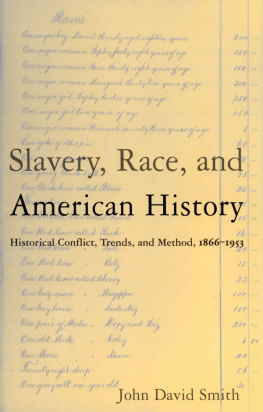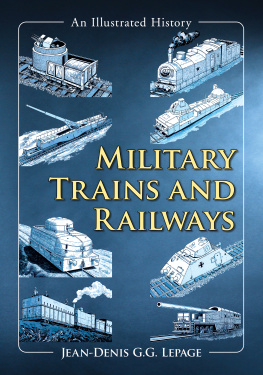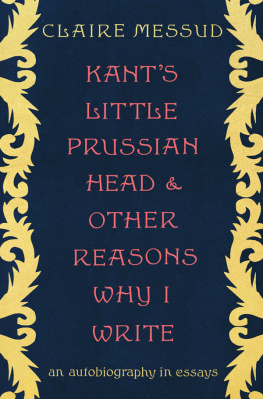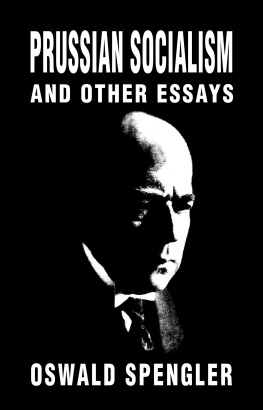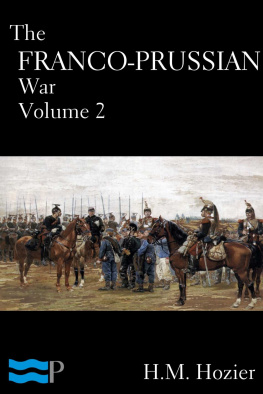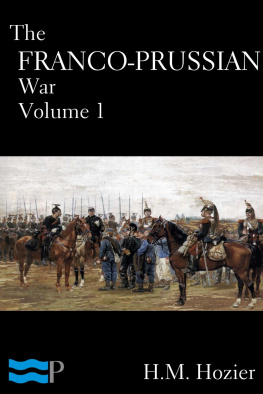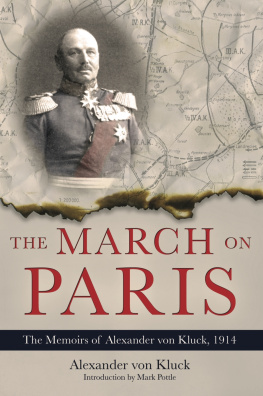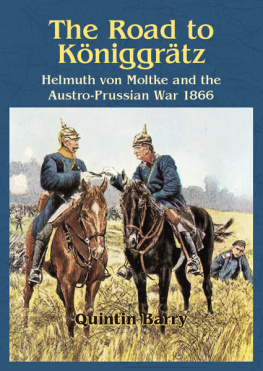H. M. Hozier - The Seven Weeks War: The Austro-Prussian Conflict of 1866
Here you can read online H. M. Hozier - The Seven Weeks War: The Austro-Prussian Conflict of 1866 full text of the book (entire story) in english for free. Download pdf and epub, get meaning, cover and reviews about this ebook. year: 2012, publisher: Leonaur, genre: Science. Description of the work, (preface) as well as reviews are available. Best literature library LitArk.com created for fans of good reading and offers a wide selection of genres:
Romance novel
Science fiction
Adventure
Detective
Science
History
Home and family
Prose
Art
Politics
Computer
Non-fiction
Religion
Business
Children
Humor
Choose a favorite category and find really read worthwhile books. Enjoy immersion in the world of imagination, feel the emotions of the characters or learn something new for yourself, make an fascinating discovery.
- Book:The Seven Weeks War: The Austro-Prussian Conflict of 1866
- Author:
- Publisher:Leonaur
- Genre:
- Year:2012
- Rating:4 / 5
- Favourites:Add to favourites
- Your mark:
- 80
- 1
- 2
- 3
- 4
- 5
The Seven Weeks War: The Austro-Prussian Conflict of 1866: summary, description and annotation
We offer to read an annotation, description, summary or preface (depends on what the author of the book "The Seven Weeks War: The Austro-Prussian Conflict of 1866" wrote himself). If you haven't found the necessary information about the book — write in the comments, we will try to find it.
H. M. Hozier: author's other books
Who wrote The Seven Weeks War: The Austro-Prussian Conflict of 1866? Find out the surname, the name of the author of the book and a list of all author's works by series.
The Seven Weeks War: The Austro-Prussian Conflict of 1866 — read online for free the complete book (whole text) full work
Below is the text of the book, divided by pages. System saving the place of the last page read, allows you to conveniently read the book "The Seven Weeks War: The Austro-Prussian Conflict of 1866" online for free, without having to search again every time where you left off. Put a bookmark, and you can go to the page where you finished reading at any time.
Font size:
Interval:
Bookmark:
Table of Contents
THE SEVEN WEEKS WAR The Seven Weeks War The Austro-Prussian Conflict of 1866 by H. M. Hozier First published under the title The Seven WeeksWar Leonaur is an imprint of Oakpast Ltd Copyright in this form 2012 Oakpast Ltd ISBN: 978-1-78282-010-9 (hardcover) ISBN: 978-1-78282-011-6 (softcover) http://www.leonaur.com Publishers Notes The views expressed in this book are not necessarily those of the publisher.
Preface to the First Edition
The only claim to consideration that the following pages can present is that for the most part they are the product of a personal eyewitness of some of the most interesting incidents of a war which, for rapidity and decisive results, may claim an almost unrivalled position in history.
The author has attempted to ascertain and to advance facts. His object has been impartiality, his aim truth. Criticism from one so feebly competent to criticise would have been entitled to no respect, and has therefore been avoided. A few observations occasionally introduced are the results not of original thought so much as of communication with some whose positive abilities and experience entitle their opinions to be attentively weighed.
MAPS The main features of the campaign of 1866 can be easily traced in any ordinary maps of Bohemia, Saxony or Moravia. Those who wish to study the details of the war, will find the maps published by the Prussian Staff at Berlin, in 1868, most lucid and serviceable. They are to be found in any large military library, and can be consulted at the Royal United Service Institution.Prefatory Chapter
The results of the war of 1866 in Germany were the aggrandizement of Prussia, the formation of new Confederations and the disappearance of Austria as a Germanic power. To the eight provinces of which Prussia consisted in the spring of 1866 were added Hesse-Cassel, Nassau, Hanover, Schleswig-Holstein and Lauenburg. These were incorporated in the Prussian kingdom and raised its population to about 23,500,000.
At the same time arose under the leadership of Prussia the new North German Confederation, the harbinger of an united German Empire. It was sixty years almost to a day when the treaty of Prague was signed in 1866, since the Emperor Francis II. had announced to the Diet his resignation of the Imperial Crown: By that act, due to the victories of Napoleon I. over Germans, the oldest political institution in the world was extinguished, for this empire was that which the nephew of Julius won for himself from the powers of the East at the Battle of Actium, and which had preserved almost unaltered through eighteen centuries of time and through the greatest changes in extent, in power, and in character, a title and pretensions from which all meaning had long since departed. (Bryce, Holy Roman Empire).
On the fall of Napoleon I. this empire was to a certain extent reconstituted by the treaty of Vienna as a Confederation of thirty-nine States. This Confederacy was extinguished in the war of 1866, and the treaty of Prague established the Confederation of the North German States, and led to the re-establishment of the Germanic Empire on a purer, more natural, and more homogeneous basis than it had ever possessed from the days of the Caesars. The treaty of Prague, however, was but the stepping-stone, not the key-stone of German Unity. North Germany numbering twenty-one States was indeed linked by that treaty into a close connection with Prussia, who held the undivided leadership, the command of the German armies, and the power of peace and war north of the Maine.
South Germany did not hold itself together. Austria stood aloof, and appeared resolved henceforth to meddle no more in German affairs. Bavaria, Wrtemburg, and Baden remained almost independent of each other, but each, on its own footing, concluded important treaties with Prussia. By that between Prussia and Bavaria, concluded on the 22nd August, 1866, these two powers mutually guaranteed the integrity of their respective territories with all the military forces at their disposal; and it was also established, that in case of war the King of Prussia should have the command-in-chief of the Bavarian army. The treaties between Prussia, Baden, and Wrtemburg, were of the same tenure; they provided a strict military alliance and submission of the armies in time of war to the King of Prussia.
In Northern Germany, in the spring of 1867, a representative assembly elected by universal suffrage at the rate of one member for every 100,000 of the population, met at Berlin in February, and by the 16th April, had discussed and adopted a constitutional charter by which the whole of the States of North Germany were definitively united into a federal body. This charter, entitled the Constitution of the North German Confederation, consists of fifteen chapters, comprising seventy-nine articles, with a preamble declaring that the governments of the States enumerated, formed themselves into a perpetual Confederation for the protection of the territory and institutions of the union, and for the guardianship of the welfare of the German people.
The twenty-one States incorporated in this Confederation were, Prussia, Saxony, Mecklenburg-Schwerin, Mecklenburg-Strelitz, Oldenburg, Brunswick, Saxe-Weimar, Saxe-Meiningen, Anhalt, Saxe-Coburg-Gotha, Saxe-Altenburg, Waldeck, Lippe-Detmold, Reuss-Schleiz, Reuss-Greiz, Schwarzburg-Sondershausen, Schwarzburg-Rudolstadt, Schaumburg-Lippe, Hamburg, Lbeck, and Bremen. The executive power of the Confederation was vested in the Sovereign of Prussia: this ruler also, as the Lord President, managed the diplomatic intercourse of the Confederation with foreign powers; was the commander-in-chief of the army and navy, and had the prerogative of nominating ambassadors, of declaring war, and of concluding peace. It was his duty to enforce the observance of federal laws, and to compel negligent or disobedient members to fulfil their federal obligations, and to appoint all officers and civil functionaries. The contributions of the various States to the cost of the general administration of the Confederation, was regulated in proportion to the numbers of their population. The King of Prussia had also to appoint a Chancellor of the Confederation who should preside over the Federal Council. The chancellor selected was naturally the Count von Bismarck.
By the terms of the Constitution of the North German Confederation, the legislative power of the Union was vested in two representative bodies. One of these bodies is elected by the governments of the Confederate States, and is termed the Bundesrath, the other is elected by the population, and is termed the Reichstag. In the Bundesrath sit deputies from the governments of each State of the Confederation; the representative of Prussia has seventeen votes, that of Saxony four, and those from Mecklenburg-Schwerin and Brunswick two each. Besides smaller German estates and the three free-towns with one vote each. All together forty-two votes. The Reichstag is elected by universal suffrage for the term of three years and meets in annual session. To the Reichstag belongs the initiative of legislative acts; it is independent of the Bundesrath, but the members of the latter have the privilege of being present it its sittings to expose the views of their respective governments.
On account of the representations of the Emperor of the French, Saxony was not, on the conclusion of the war of 1866, so completely absorbed into the North German Confederation as her more northern neighbours. The King of Saxony, although a member of the Union, still retained the power of nominating officers, civil and military, in his kingdom, and the Saxon Army was not merged in that of the Confederation. It was, however, to be held under the supreme orders of the King of Prussia in case of war.
Next pageFont size:
Interval:
Bookmark:
Similar books «The Seven Weeks War: The Austro-Prussian Conflict of 1866»
Look at similar books to The Seven Weeks War: The Austro-Prussian Conflict of 1866. We have selected literature similar in name and meaning in the hope of providing readers with more options to find new, interesting, not yet read works.
Discussion, reviews of the book The Seven Weeks War: The Austro-Prussian Conflict of 1866 and just readers' own opinions. Leave your comments, write what you think about the work, its meaning or the main characters. Specify what exactly you liked and what you didn't like, and why you think so.


